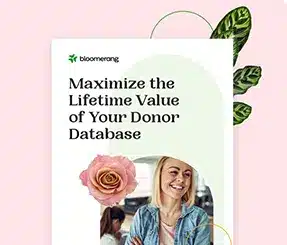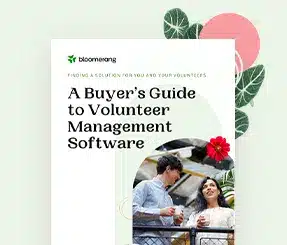GivingTuesday 2025: The Ultimate Guide for Nonprofits


Full Platform Overview Chat With Us



Full Platform Overview Chat With Us




GivingTuesday is a global celebration of generosity, community, and collective positive impact. Held the Tuesday after Thanksgiving, this powerful giving movement mobilizes supporters worldwide and sparks a surge in donations right when year-end fundraising picks up.
For nonprofit fundraising professionals like you, GivingTuesday is a prime opportunity to amplify your mission, rally your community, and finish the year strong.
Not sure if your organization is ready to seize the moment? This guide will walk you through everything you need to confidently plan, promote, and profit from GivingTuesday. Here’s what we’ll cover:
According to the official website, GivingTuesday is a “global generosity movement unleashing the power of radical generosity.” The name “GivingTuesday” refers to the fundraising event and the nonprofit organization that began the campaign.
When GivingTuesday first began, it was a social media movement. The event name was stylized as #GivingTuesday for easy sharing across social media platforms. The basic naming structure was maintained after the event went global and multichannel. You might also see variations like Giving Tuesday or Giving-Tuesday, but the official spelling now is “GivingTuesday.”
Any individual or charitable organization can participate in this giving initiative. Organizations in the U.S. do not have to be 501(c)(3)s as long as they clearly state that supporters’ gifts will not be tax-deductible.
The first GivingTuesday was held in 2012. It was founded to focus on gratitude and giving back to the community after the shopping-heavy days of Black Friday and Cyber Monday.
GivingTuesday 2025 is on Tuesday, December 2, 2025.
GivingTuesday 2024 was a record-breaking year, with 36.1 million people donating $3.6 billion to charitable organizations in the U.S. (a 16% donation increase from 2023). According to the GivingTuesday organization, the sum of GivingTuesday donations since its launch in 2012 is more than $18.5 billion.
You do not need to register with the GivingTuesday organization or any other organization to participate in this giving day. You can independently start a campaign to support your nonprofit and freely collect donations on this day.
Want to plan a GivingTuesday strategy for your nonprofit? Start here with our top tips for maximizing giving this year.
Although GivingTuesday can be an incredible fundraising opportunity for nonprofits, it’s just the beginning of the lucrative year-end fundraising season. Year-end fundraising peaks on December 31 as donors send their final tax-deductible gifts for the year.
The M+R Benchmarks 2025 report found that nonprofits received 40% of their 2024 online revenue in December. The study also determined that nonprofits raised an average of 11% more on December 31, 2024, than on December 31, 2023.
Your nonprofit needs a well-built-out plan for GivingTuesday. We recommend starting the planning process in September. That will give your fundraising team enough time to plan your outreach and refresh your online presence.
Here’s what your 2025 timeline could look like:
Meet with your fundraising team regularly throughout these final months of the year to assign tasks, sync on progress made, work through challenges, and ensure total alignment with next actions. Set clear task owners and deadlines for each activity. For instance, you could assign one team member to draft all email and social copy by October 15 to give your team leader enough time to review and approve the content.
Your online campaign page should streamline the giving process for your supporters, making it as easy as possible for them to send in their donations. Optimize your GivingTuesday campaign page and donation form by ensuring it has:
You can perform A/B testing on your GivingTuesday campaign page to identify the strategies that resonate most with your audience.
For example, you might create one version of the page featuring a single-page form and another version with a multi-step form. Test both pages by sending them to separate groups of donors before GivingTuesday to determine which option generates the highest revenue.
GivingTuesday is a day dedicated to online giving, making it essential for nonprofits to primarily reach out through digital platforms. Specifically, social media will be your most effective tool for sharing updates about your GivingTuesday campaign.
Use these tips to make the most of your social media presence:
Track social media engagement metrics throughout the day, such as likes, shares, comments, and donations. You can use this data to improve future social media campaigns and pivot your strategy on GivingTuesday.
For example, suppose you notice video content performing particularly well throughout the day. In that case, you can focus on sharing more videos of testimonials, behind-the-scenes looks, and campaign updates from your fundraising staff members.
Along with social media, email is another useful platform to contact supporters online. Optimize your email outreach with these best practices:
Lastly, use eye-catching subject lines so your emails stand out in recipients’ inboxes. Urgent, personalized appeals tend to be effective for inspiring immediate giving. For instance, a subject line saying “Rebecca, only 12 hours left to get your GivingTuesday gift matched by a generous donor!” is more engaging than one saying “Donate to our GivingTuesday matching gift drive today!”
While double-checking the functionality of your donation form may not be the most exciting task in the world, it can save you a lot of heartache. Don’t let half of GivingTuesday pass you by before discovering that donors can’t find your campaign page or your online donation forms aren’t working!
Test the donor journey by answering these questions:
A streamlined donor journey encourages more GivingTuesday donations and increases donors’ trust in your organization, leading to greater long-term support.
Keep in touch with supporters throughout GivingTuesday by planning multiple day-of touchpoints.
Some strategies you might employ to keep in touch with supporters include:
Give shoutouts to supporters who go above and beyond to support your campaign. For example, you could share a “Top Donor of the Hour” social media post featuring the most significant gifts from every hour of GivingTuesday. Or, you could host an Instagram Live where you read out donors’ names in real-time as their gifts roll in.
Your GivingTuesday campaign should not only focus on acquiring new donors but also on retaining them for the long term. Check out this example from our donor retention guide showing the impact of a nonprofit increasing its retention rates by just 10%:
As you can see, retaining more donors allows your organization to earn more revenue over time.
Use these strategies to retain different types of GivingTuesday donors:
Invite donors into your nonprofit’s community to show them that you care about building real relationships with them as individuals. This approach is a much more effective way to build long-term loyalty than occasional fundraising requests.
Your nonprofit collects a lot of valuable information throughout GivingTuesday. Don’t let this information simply sit in your database. Instead, analyze campaign results to optimize future efforts.
Review metrics such as:
With this data, you can determine how effectively your campaign reached new audiences, engaged existing supporters, and supported your mission.
Your GivingTuesday fundraising efforts will be more successful when you offer supporters a compelling reason to get involved. The more engaging or interactive your campaign is, the better! With that in mind, here are some campaign ideas to make your GivingTuesday event a smashing success:
Your organization could choose to focus on one of these ideas or combine multiple strategies into a larger campaign. Consider your fundraising team’s size and capacity when making this decision.
Also, think about what your organization already does well. If your previous text-to-give campaigns have been a smashing success, build on that momentum during your GivingTuesday outreach efforts.
Bloomerang is the unified, efficient giving platform your organization needs to grow your impact. If you feel pulled in opposite directions leading up to the year-end giving season, Bloomerang can help streamline your planning efforts and free up your time to focus on your mission.
Bloomerang offers the following fundraising tools to ensure your GivingTuesday campaign goes off without a hitch:
Plus, Bloomerang’s strong focus on donor retention empowers nonprofits to continue building relationships with new donors even after GivingTuesday ends. Leverage our donor management solution to build on past interactions, personalize your outreach, and identify donors who are ready to upgrade their giving.
Watch this video to learn more about how Bloomerang powers your purpose, helping your organization have a greater impact in its community:
Bloomerang organizes your data and connects essential information across platforms. As a result, your fundraising team can do what it does best—build genuine relationships with supporters that can last a lifetime.
With an impactful plan, your nonprofit will be ready to rock GivingTuesday this year. Equipped with these expert tips and creative GivingTuesday ideas, you’re off to a great start.
Check out our additional fundraising resources to optimize all aspects of your campaign:

Comments
ofhsoupkitchen
Max Harris